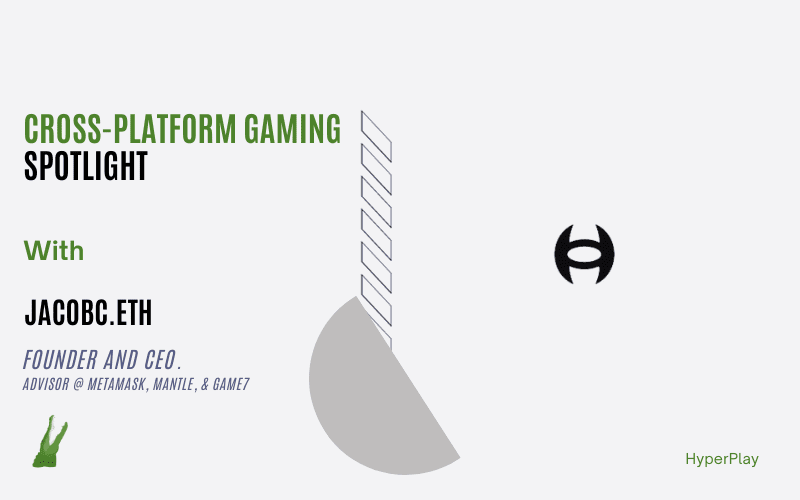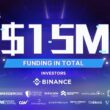Quick take:
- Formerly the operations lead at MetaMask, Jacob’s advisory role now focuses on gaming strategy at the crypto wallet provider.
- His company focused on facilitating interoperability across the decentralized web to advance Web3 gaming.
- Although he sees a bright future for blockchain gaming, Jacob does not expect the industry to replace traditional gaming.
Blockchain games may not be as popular as they were about 18 months ago amid a prolonged crypto winter. However, over the past few months, the industry has started to bounce back, with those who joined for fear of missing out (FOMO), now weeded out of the market.
More importantly, over the past year, blockchain gaming companies have been focusing on building the technologies necessary for bringing the industry to the masses. From interoperability protocols and game developer kits, we have seen Polygon, team up with Immutable to launch Immutable zkEVM gaming marketplace and Oasys onboard some of the traditional gaming industry’s biggest companies as validators.
Whilst the technology has helped developers easily build and launch cross-chain gaming projects, other players like Jacob’s HyperPlay have focused on solving the distribution problems.
Amid the crypto winter, last June HyperPlay raised $12 million in a Series A round led by Griffin Gaming and BITKRAFT Ventures. Receiving support from some of the industry’s leading Web3 investment companies has seen HyperPlay build what it calls “censorship-resistant game distribution channels for Web3 game developers.”
“The overarching goal is to establish interoperability as the standard for all Web3 games, offering gamers a seamless transaction experience and the ability to carry assets across different games,” Jacob told NFTgators in a written interview.
Co-founded with MetaMask, HyperPlay was incubated inside the Game7 DAO, the decentralised autonomous organisation that governs the Web3 gaming studio Game7.
In this Q&A Jacob discusses his strong passion for building the next generation of games and why he thinks blockchain games do not need to replace traditional games in order to succeed.
Please tell us about yourself and your journey in Web3 gaming.
As a lifelong gamer, I have a deep passion for building the next generation of gaming experiences. Traditional gaming distribution platforms are incredibly monopolistic, resulting in censorship, restricted player autonomy, and reliance on the platform’s walled garden.
I co-founded HyperPlay to free both players and game developers from centralized control. We believe that solving the distribution problem is critical to enabling games to fully leverage everything possible in Web3 but prohibited in web2 platforms. We want to liberate game developers from the fear of being de-platformed by dominant companies such as Apple, Google, and Steam. Unlike the Apple Store, we don’t impose a 30% tax on your developers’ in-game earnings (or any taxes for that matter). Our product is the most developer-loyal game distribution platform.
As a MetaMask advisor, what exactly does your role entail, and does MetaMask have any connection with HyperPlay?
I was previously Lead of Operations at MetaMask largely focused on growth and monetization strategies, so I’m still involved in supporting many of the builders creating the different aspects of the MetaMask ecosystem. These days as a strategic advisor, my role mainly focuses on gaming strategy and helping MetaMask support the growing games ecosystem.
HyperPlay was developed in partnership with MetaMask and incubated inside the Game7 DAO. As a Web3 native game store, HyperPlay enables players to bring their MetaMask wallet into any game, be it native or browser-based.
HyperPlay allows players to carry their MetaMask wallet into every game through a wallet overlay. Similar to how Steam overlays chat windows and notifications on top of games, HyperPlay overlays the players’ wallet on top of games so that assets and reputation can be used interoperably across every game, no matter whether the game is native or browser-based.
What distinguishes HyperPlay from other gaming marketplaces?
HyperPlay focuses on creating censorship-resistant game distribution channels for Web3 game developers. The overarching goal is to establish interoperability as the standard for all Web3 games, offering gamers a seamless transaction experience and the ability to carry assets across different games. HyperPlay’s capacity to facilitate interoperability across the decentralized web positions it as a catalyst for a revolutionary shift toward decentralized gaming.
What is the biggest challenge blockchain games are facing and how is your company addressing the issue?
One of the biggest challenges we’re tackling is accessibility. Playing blockchain games is often cumbersome: it’s difficult to connect a wallet and tricky for the developer to integrate it with the game, it’s complicated to switch between games built on different chains and with siloed wallets, and it’s not uncommon for players to spend more time fiddling with configurations than actual gaming. On top of this, many major game launchers and storefronts have banned Web3 games, leaving them relegated to Web3-specific platforms.
Even the platforms that do allow Web3 games prevent those games from having meaningful usage of smart contracts or self-custodial wallets and effectively prohibit the value propositions of Web3. This has created a sharp and inconvenient divide between Web2 and Web3 content – there’s no central hub to play both innovative Web3 titles and classic AAA blockbusters. Playing Web3 games has historically been a pretty annoying process.
We’re changing that with HyperPlay, and providing gamers with a slick interface that makes loading and playing Web3 games as simple as turning on an Xbox or loading up Steam. To start, we built the player’s wallet into the fabric of our platform. HyperPlay provides a convenient wallet overlay so that no matter which game you launch, your wallet and all of your assets are always a click away. Using MetaMask wallets means that HyperPlay natively supports over 100 blockchains – every single blockchain that MetaMask supports. Rather than building walls around our platform, we’ve made it extensible.
It’s not only essential to unite the Web3 gaming community but also to bridge the arbitrary divide between Web2 and Web3 gaming. In addition to offering native Web3 content, HyperPlay also aggregates other storefronts, including the Epic Games Store. Gamers can load up Web3 games alongside the latest major studio release and simply play the games they enjoy, not the games they’re allowed access to.
How long before blockchain games go mainstream, and do you think they really are the future of gaming?
I certainly think Web3 games are a very important part of the future of gaming – I expect we’ll see Web3 games win Game Of The Year awards, anchor holiday release schedules, and expand the limits of what’s possible with gaming. The industry has done an incredible job of optimizing and expanding the utility of blockchain networks and attracting young talent – now that these cutting-edge tools are in developers’ hands it’s only a matter of time until viral mainstream hits emerge.
That said, I think that arguing that Web3 games are the absolute future of gaming is silly. 3D games did not replace 2D, MMOs didn’t replace single-player JRPGs, and motion tracking didn’t replace controllers. They all coexist, serve different purposes, and appeal to different audiences. The reason that gaming is so loved by so many is that it’s a diverse art form, and Web3 games are just one important component of a divergent tapestry.
Given the stance taken by the SEC on crypto, where do you see the Web3 industry in the US, in five years?
It’s no secret that many regulatory bodies have been hostile toward anything to do with blockchain or cryptocurrency. It’s not just the SEC – in fact, the ESRB recently began rating nearly all Web3 games “Adults Only”, an absurd rating typically reserved for only pornographic content. There are certainly barriers in the way to success that are exclusive to this segment of gaming.
That said, the investment, growth, and interest in this industry is undeniable. We’ve seen major publishers, including Unity, Square Enix, and Tencent, make massive investments in Web3 technology, many in the past year. There’s enough investment, interest, and developer talent behind this movement to overcome the regulatory obstacles and cement Web3 gaming as a major segment of the industry within five years.
In June 2023, your company announced a $12 million Series A round led by Griffin Gaming Partners and BITKRAFT Ventures. What does it take for a Web3 startup to attract such top backers?
We’re fortunate to have incredible investors supporting us on our journey to empower Web3 gaming developers and users. Our product had received product-market fit and our team was composed of many different founders with incredible track records, so we were in a position where many highly qualified funds reached out to us directly.
To raise funding from top VCs, ensure your project has strong differentiators, a team of seasoned blockchain leaders, and a clearly defined roadmap. Additionally, anticipate potential rejections and use feedback as a learning opportunity. The fundraising journey demands persistence, adaptability, and a resilient mindset for success.
Web3 funding has declined over the past eight quarters, any tips for a Web3 startup looking to fundraise in the current climate?
Keep building and cultivating an engaged community. Market downturns may seem prolonged, but there is a genuine resurgence of interest in blockchain technologies from venture capitalists, institutional players, and established Web2 companies.
Strong communities are the beating heart of Web3. Engaging with a collaborative community provides crucial feedback to significantly enhance your project and improve user experience. These communities provide a sense of belonging, trust, and shared purpose, which is essential for the successful adoption of decentralized technologies.
Is there anything else related to recent events in Web3 you would like to comment on?
This is an exciting time for the Web3 gaming landscape. While the bear market posed significant challenges to gaming projects and the entire Web3 ecosystem, we’re already seeing signs of life at the start of 2024. Between 2021 and 2022, there was a remarkable surge of 2000% in the growth of Web3 gaming. With the ongoing positive momentum and a growing influx of venture capital into the sector, we can expect even more explosive growth as we approach a bull market.
In the next bull market, I’m looking forward to seeing more top-notch Web3 games capable of bridging diverse communities into the decentralized web. Blockchain games have the power to usher in mass Web3 adoption by offering improved user experiences, eliminating confusing technical jargon, and crafting engaging storylines.
****
Stay up to date:
Subscribe to our newsletter using this link – we won’t spam!





